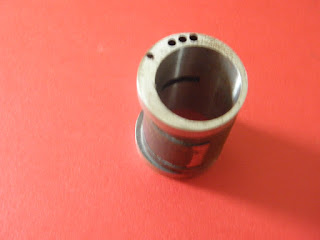EXTENDING BEARING LIFE
Abstract:Nature works hard to destroy bearings, but their chances of survival
can be improved by following a few simple guidelines. Extreme neglect in a
bearing leads to overheating and possibly seizure or, at worst,
CnC machining an explosion.
But even a failed bearing leaves clues as to what went wrong. After a little
detective work, action can be taken to avoid a repeat performance.
Keywords: bearings failures
life
Bearings fail for a number of reasons,but the most common are misapplication,contamination,improper
lubricant,shipping or handling
damage,and misalignment. The
problem is often not difficult to diagnose because a failed bearing usually
leaves telltale signs about what went wrong.
However,while a postmortem
yields good information,it is better to
avoid the process altogether by specifying the bearing correctly in The first
place.To do this,it is useful to review the manufacturers sizing guidelines and
operating characteristics for the selected bearing.
Equally critical is a study of requirements
for noise, torque, and runout, as well as possible exposure to contaminants, CnC machining hostile liquids, and temperature extremes. This can provide further clues as to
whether a bearing is right for a job.
Why bearings fail
About 40% of ball bearing failures are caused by contamination from dust, dirt, shavings, and corrosion. Contamination also causes torque and noise problems, and
is often the result of improper handling or the application environment.Fortunately, a bearing failure caused by environment or handling
contamination is preventable,and a simple
visual examination can easily identify the cause.
Conducting a postmortem il1ustrates what to
look for on a failed or failing bearing.Then,understanding the
mechanism behind the failure, such as brinelling or fatigue, helps eliminate
the source of the problem.
Brinelling is one type of bearing failure easily avoided by proper
handing and assembly. It is characterized by indentations in the bearing
raceway caused by shock loading-such as when a
bearing is dropped-or incorrect assembly. Brinelling usually occurs when loads
exceed the material yield point(350,000 psi in SAE 52100 chrome steel).It may also be caused by improper assembly, Which places a load
across the races.Raceway dents also
produce noise,vibration,and increased torque.
A
similar defect is a pattern of elliptical dents caused by balls vibrating
between raceways while the bearing is not turning.This problem is called false brinelling. It occurs on equipment in
transit or that vibrates when not in operation. In addition, debris created by
false brinelling acts like an abrasive, further contaminating the bearing.
Unlike brinelling, false binelling is often indicated by a reddish color from
fretting corrosion in the lubricant.
False brinelling is prevented by eliminating vibration sources and
keeping the bearing well lubricated. Isolation pads on the equipment or a
separate foundation may be required to reduce environmental vibration. Also a
light preload on the bearing helps keep the balls and raceway in tight contact.
Preloading also helps prevent false brinelling during transit.
Seizures can be caused by a lack of internal
clearance, improper lubrication, or excessive loading. Before seizing,
excessive, friction and heat softens the bearing steel. Overheated bearings
often change color,usually to
blue-black or straw colored.Friction also
causes stress in the retainer,which can break
and hasten bearing failure.
Premature material fatigue is caused by a high load or excessive preload.When these conditions are unavoidable,bearing life should be carefully calculated so that a maintenance
scheme can be worked out.
Another solution for fighting premature fatigue is changing material.When standard bearing materials,such as 440C or SAE 52100,do not guarantee sufficient
life,specialty materials can
be recommended. In addition,when the
problem is traced back to excessive loading,a higher capacity bearing or different configuration may be used.
Creep is less common than premature fatigue.In bearings.it is caused by
excessive clearance between bore and shaft that allows the bore to rotate on
the shaft.Creep can be expensive
because it causes damage to other components in addition to the bearing.
0ther more likely creep indicators are scratches,scuff marks,or
discoloration to shaft and bore.To prevent
creep damage,the bearing housing and
shaft fittings should be visually checked.
Misalignment is related to creep in that it is mounting related.If races are misaligned or cocked.The balls track in a noncircumferencial path.The problem is incorrect mounting or tolerancing,or insufficient squareness of the bearing mounting site.Misalignment of more than 1/4·can cause an early failure.
Contaminated lubricant is often more difficult to detect than
misalignment or creep.Contamination
shows as premature wear.Solid
contaminants become an abrasive in the lubricant.In addition。insufficient
lubrication between ball and retainer wears and weakens the retainer.In this situation,lubrication is
critical if the retainer is a fully machined type.Ribbon or crown retainers,in contrast,allow
lubricants to more easily reach all surfaces.
Rust is a form of moisture contamination and often indicates the wrong
material for the application.CnC machining If the material
checks out for the job,the easiest way
to prevent rust is to keep bearings in their packaging,until just before installation.

没有评论:
发表评论